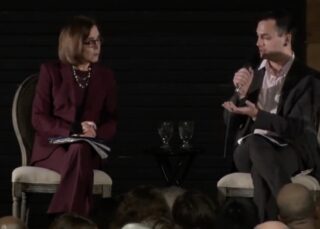
Governor Kate Brown spent about an hour with members of the City Club of Portland today. At the event, a preview of the 2020 legislative session, Brown fielded two questions about the controversial I-5 Rose Quarter project.
As we reported Thursday, the Oregon Department of Transportation and their bosses at the Oregon Transportation Commission (OTC) are facing an intense barrage of questions and concerns from elected officials and community groups over their plans to expand I-5 between I-84 and I-405.
“How do you reconcile these big investments in fossil fuel infrastructure with a climate justice vision?”
— Colin Jones, moderator
The first question for Governor Brown came from Chris Smith, a noted transportation reform activist who happens to have a seat on the City of Portland Planning & Sustainability Commission and has just launched a campaign for Metro district 5.
Chris Smith:
“You said yourself transportation is the largest sector of greenhouse gas emissions from the state. Last year, during the comment period for the Rose Quarter freeway expansion, more than 2,000 comment were received. 90% of them opposed the project or asked for a full Environmental Impact Statement — yet the OTC appears poised to move forward without an EIS. First question: Do you expect the commissions you appoint to listen to public comments? And second question: Will you ask for an EIS?”
Advertisement
Governor Brown:
“As I mentioned in my remarks, transportation is 40% of our greenhouse gas emissions statewide and the best strategy to reduce carbon in transportation is an economy-wide, market-based approach with enforceable limits. And that’s the proposal on the table in the legislative session [referring to the latest version of Oregon’s cap-and-trade bill]. Absolutely, we must address the Rose Quarter issue to increase safety and at the same time we can do this with a layer of congestion pricing which should reduce carbon emissions overall.
In terms of your question of do I expect members of my boards and commissions to listen to public comments… Absolutely, and I believe that the OTC is doing that.”
Then moderator Colin Jones asked the Governor a similar question (based on “dozens” he received on Twitter before the event):
“You talked about the transportation bill [HB 2017], which included significant investments in public transit — which is what you tend to talk about — but it also included a couple hundred million in fossil fuel infrastructure in the form of the Rose Quarter freeway expansion and a lot of the folks see the CRC 2.0 project coming to life again. So, how do you reconcile these big investments in fossil fuel infrastructure with a climate justice vision?”
Advertisement
Governor Brown:
“Transportation is 40% of our greenhouse gas emissions. We need to make sure we reduce carbon in transportation through an economy-wide, market-based approach. I think we can do both, honestly. The investments in the Rose Quarter… Safety: We can do this in a way with a layer of some type of congestion pricing will provide safety, as well as carbon emission reductions — obviously when people are idling on I-5 at that particular pinch-point you’ve got a lot of congestion, a lot of emissions happening there.”
Reached after the event, Chris Smith shared his thoughts on the Governor’s answer to his question: “She suggested that the Oregon Transportation Commission is doing a good job listening. That’s hard to reconcile since they are neither stopping the project, nor do they appear to be headed to an Environment Impact Statement.”
There are a few notable takeaways from Brown’s answers.
She answered both questions with nearly identical talking points. This makes it clear she spoke from prepared remarks. The inclusion of congestion pricing in her answers gives more momentum to price freeway lanes as soon as possible. While some local electeds like Portland Commissioner Chloe Eudaly and Metro Council President Lynn Peterson (who was in the audience today) have explicitly called for pricing before construction begins, Brown stopped short of doing so today. When it comes to the safety rationale for the project, that’s dubious to say the least.
Brown’s remarks today make it clear she feels reducing idling (by alleviating congestion) is a climate change strategy. That would align her directly with the newly named ODOT Director Kris Strickler. But context matters. If she made these remarks in the context of a question about investments in alternatives to driving, she would win fans among transportation reform advocates. But in the context of questions about a project that will expand lanes on a freeway, some might think she either isn’t aware of induced demand, doesn’t believe in it, or that she’s simply disengaged from the project and is comfortable parroting ODOT talking points. (Note: Brown’s Transportation Policy Advisor Brendan Finn starts a new job as Director of ODOT Office of Urban Mobility and Mega Project Delivery (being formed specifically to “deliver” the I-5 Rose Quarter project) on March 1st.)
The Governor also didn’t answer Smith’s question about the EIS. When I asked the same question about a month ago, her office said, “The Governor appreciates the OTC taking time to address some of the local partnership issues articulated in her letter and will support the federal environmental review path they decide on.”
— Jonathan Maus: (503) 706-8804, @jonathan_maus on Twitter and jonathan@bikeportland.org
— Get our headlines delivered to your inbox.
— Support this independent community media outlet with a one-time contribution or monthly subscription.


